Offshore Feedering: Supporting Global Energy Transition Practically
Using feeder barges to supply wind turbine components to precious offshore installation vessels seems like a no brainer. But why shuttle cargo with your most expensive and time-critical piece of equipment? While becoming more common practice in near shore and benign environments, the industry has yet to reach consensus on how this can be practically achieved in the global market. Minor changes in the details can make or break your workability or introduce unacceptable risk into your campaign. The US market highlights the need for practical solutions to barge feedering which can be applied to global markets to support the current and future appetite of offshore renewables. The Feeder Alliance is a collaboration of innovative companies looking to provide a detailed, innovative approach to barge feedering.
They’re called installation vessels not cargo vessels!
The offshore wind installation market is constantly maturing, but large steps can still be made, especially in the supply chain. Currently most Wind Turbine Installation Vessels (WTIV’s) are jack-ups, specifically designed for the delicate, fixed base and motion free installation of offshore wind turbine (OWT) components. All processes and equipment onboard are carefully designed such that the installation time per turbine is minimized. Currently a crew can install at full OWT in less than 24hrs, down from around 48 to 72hrs twenty years ago, greatly reducing costs on a full installation campaign usually requiring around 100 such installations.
Yet most of these WTIV’s are also used to shuttle their own supply from the marshalling harbor to the installation site. This means taking the most expensive, time-constrained piece of equipment away from its core duties to assume its role as a cargo vessel. It is a habit taken over from the traditional offshore installation industry that consumes approx. 35-40% of the WTG installation campaign’s time. The offshore wind market requires between 80 to 150 OWT’s installed per campaign, each consisting of 3 to 8 pieces that need to be supplied and installed. It is not uncommon for the WTIV’s to travel back to harbor load and transport turbines between 25 and 50 times per campaign.
This does not feel like the optimal process to anyone, which is why more and more contractors are investigating how to use feeder barges to bring their supplies: simple flat barges, designed to do what is needed: reliable and effective delivery of components to the installation site, keeping the $300k per day high-spec WTIV’s doing what they do best: installing turbines!
Offshore Wind Feeder Barges brought to the forefront by US market.
There is a special reason why this type of logistical operation is currently of keen interest, that is the promising US offshore wind market. Here, the Jones Act prohibits the transport of turbine components & supplies from a US harbor to a US offshore installation site by a non-coastwise compliant vessel. Background to this are the Outer Continental Shelf Lands Act and its interpretation by the Merchant Marine Act of 1920 (Jones Act) along with rulings from Customs and Border Protection (CBP) that will prevent such vessels to transport wind turbine components from a US marshalling port to a monopile once it is connected to the seabed. The construction of the first Jones Act compliant WTIV has just started, so all eyes are on the use of feeder barges to keep the supply coming. This first and only Jones Act compliant WTIV will likely be occupied until 2026, while there are a multitude of other projects that will need be operational by that time. Further complications such as bridges limiting access to marshalling harbors (e.g. the Chesapeake Bay Bridge near the Trade Point Atlantic, or the Verrazano-Narrows Bridge near South Brooklyn) block the entry of any next generation jack-up vessel with their legs jacked up. These facts only strengthen the case for floating feedering.
Feedering, not as easy as it seems.
The case for feedering is clear cut, while successful execution is still a difficult puzzle that all installation contractors are now putting together. There are four clear hurdles that need to be tackled to unlock its potential:
1. Guarantee safe offshore lifting operations – Rigging crew on heaving barges must work with heavy crane equipment and significant cargo motions. What is needed to do this in a safe way? How can we eliminate risk of crew and cargo?
2. Compensate relative motions – Lifting loads using a jacked crane from moving barges can damage cranes, or the delicate and expensive components. How to protect the assets and the safety of the crew?
3. Barge station keeping while keeping up workability – Mooring the barge to the jack-up is a practical solution, however it limits workability significantly. Poor soil conditions could mean an increase in jacking times of the WTIV to up to 20 hrs. During this operation sea states can change drastically leaving the moored barge in an unfavorable heading since it cannot weathervane. Secondly to avoid mooring to the jack up legs, modifications to the Feedering barge are required together with a very low airgap below the WTIV, both introduce additional risks and costs.
4. Minimize costs of additional feeder vessel – Will the costs of additional marine spread outweigh the time saved on the WTIV? Using a barge, a simple asset that the US market can fabricate at relative low cost will help keeping overall cost down.
How to increase your operability
To be able to successfully feed WTG components to the WTIV we need to overcome the abovementioned challenges. Solving these challenges will take more than one company and more than one technology. We believe that by working closely together with clients and partner companies we can combine multiple state of the art technologies to make Barge Feedering the new standard. Therefore, the Feeder Alliance started a joint increased operability study proving that a significant increase of operability can be achieved by combining multiple technologies while keeping costs down.
Combine emerging technology, legacy equipment, and local content.
The foundation of floating feedering success lies with local content and legacy assets. In the current US market, the local established towage contractors are being overshadowed for work scopes they are very capable of. Using feeder barges will limit the barrier of entry to local towage contractors and barge owners giving them the ability to bid for enormous offshore transportation scopes.
ADAPT barge with integrated DP2 technology.
We partner with local asset owners to bring a more advanced feeder barge to the market, the ADAPT barge (Autonomous Delivery And Installation Platform Technology). These barges are designed to be towed to the WTIV safety zone by smaller non-DP tugboats. Due to the onboard all electric thrusters and DP2 control system the barge can safely approach and keep station alongside the WITV and TP.
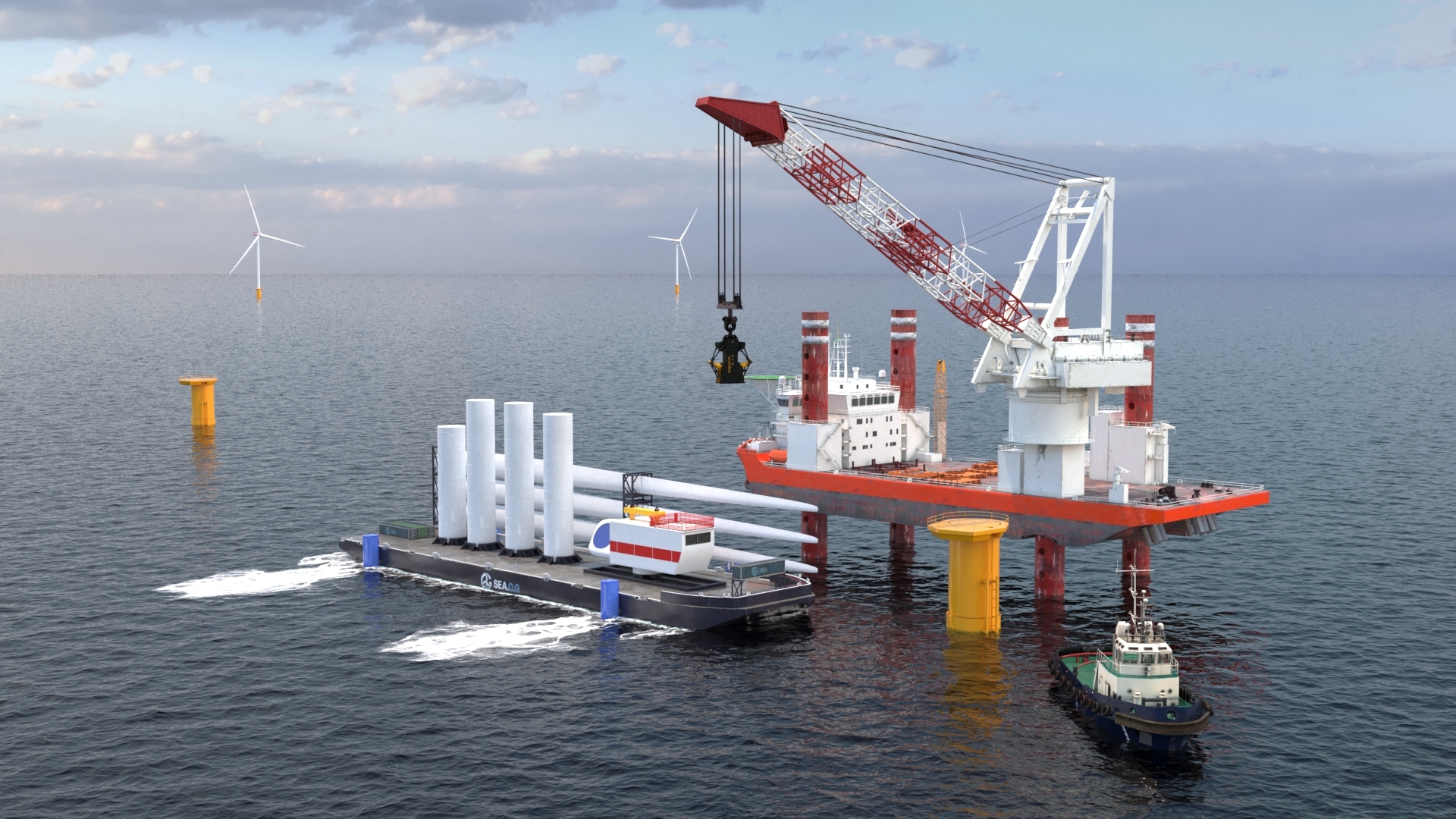
The onboard equipment allows for offshore execution in optimal heading (maximum 15-degree head or stern seas) to achieve highest operability for the specific lifting operation. This will bring a significant increase of your operability. Also, the use of DP systems avoids contact with the seabed or any other floating structure creating the fastest, safest, most ecofriendly method of positioning.
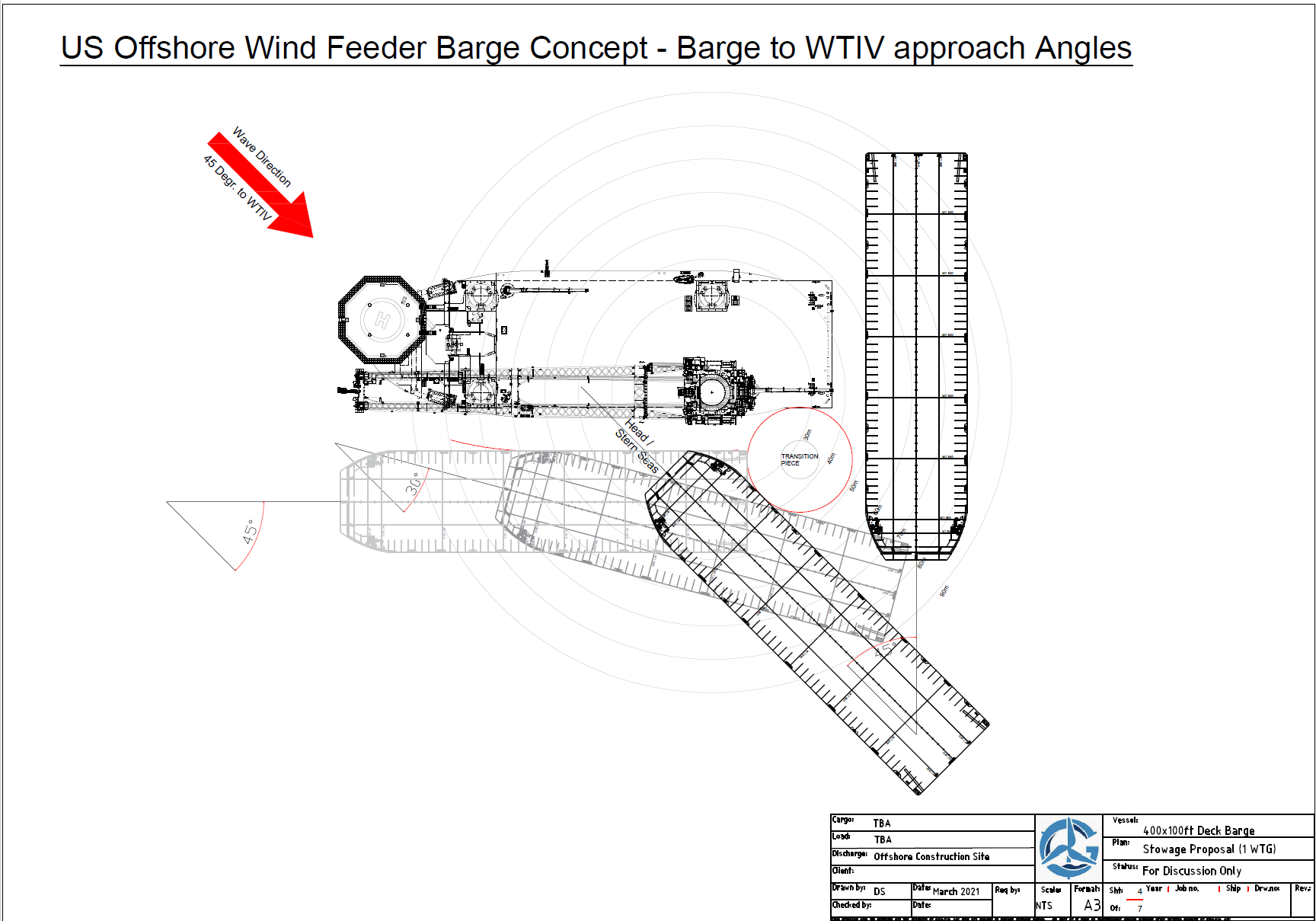
Fully controllable inline active heave compensation: safe lifting in higher seas
Lifting the WTG components (ranging ~200mT to ~1000mT) from a heaving feeder barge deck is a delicate operation. Any damage to the items can cause significant delay due to repairs or even aborted operations. But waiting for good weather can be an expensive solution. Key risks that need to be avoided are excessive dynamic loads (DAF) that go beyond crane capacity, snatch loads/premature lift-offs, and slow lift-offs that cause re-hits with the heaving deck.
Offshore tooling developer Seaqualize has developed the first inline Active Heave Compensation (i-AHC) tool for heavy in-air lifts. It offers:
- “Follow-mode” where the rigging connection point can match the speed of the feeder barge and cargo and follow the cargo which facilitates remote rigging.
- By compensating the heave motion, the load in the rigging can be built up gradually and kept at a safe, constant tension level (say 90% of the weight) to allow for a safe release of the seafastening.
- An adjustable, gradual load built up to keep the DAF load into the crane rigging under 110%
- A quick-lift of 50cm/s timed automatically at a top of a heaving wave, preventing any re-hits and significantly increasing the operability
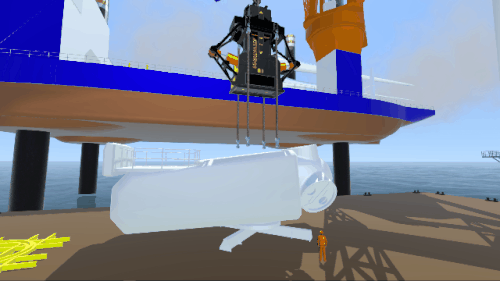

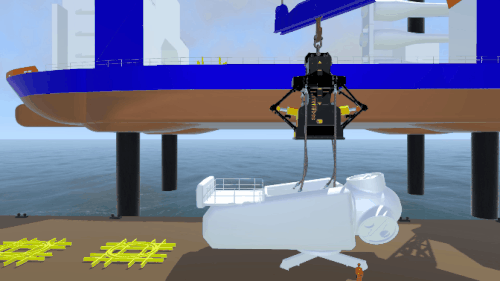
The inline-AHC covers the full range of payloads, without the need to recharge or come back to deck for new settings. This means continuous operations, at a high level of workability.
Safe Offshore Lifting Operations – Smart Sea fastening and Lifting Devices
Feedering requires safe, swift and damage free transport and lifting of wind farm foundations and WTG components. The deployment of rigging crew on the feeder barge vessel is an enormous operational risk, as it requires them to be in the vicinity of huge pieces of swinging equipment such as crane blocks and lifting yokes. With today’s technology the rigging and release operation could be done fully autonomous, this requires smart rigging and seafastening release solutions that will work together:
- Smart release: remote controlled quick release systems, including passive pitch-/roll compensation for e.g. tall tower sections;
- Smart rigging: fully autonomous means of fitting the rigging to the lifting bar of the TP, Blade rack, nacelle or tower, by using guides and smart sling catchers.
The engineering firm Eager.one has developed a range of lifting and handling tools that are remote controlled and battery powered. Together with remote released seafastening, the offshore crew can safely lift all items from the feeder barge using integrated rigging and modular seafastening with a remote released system.
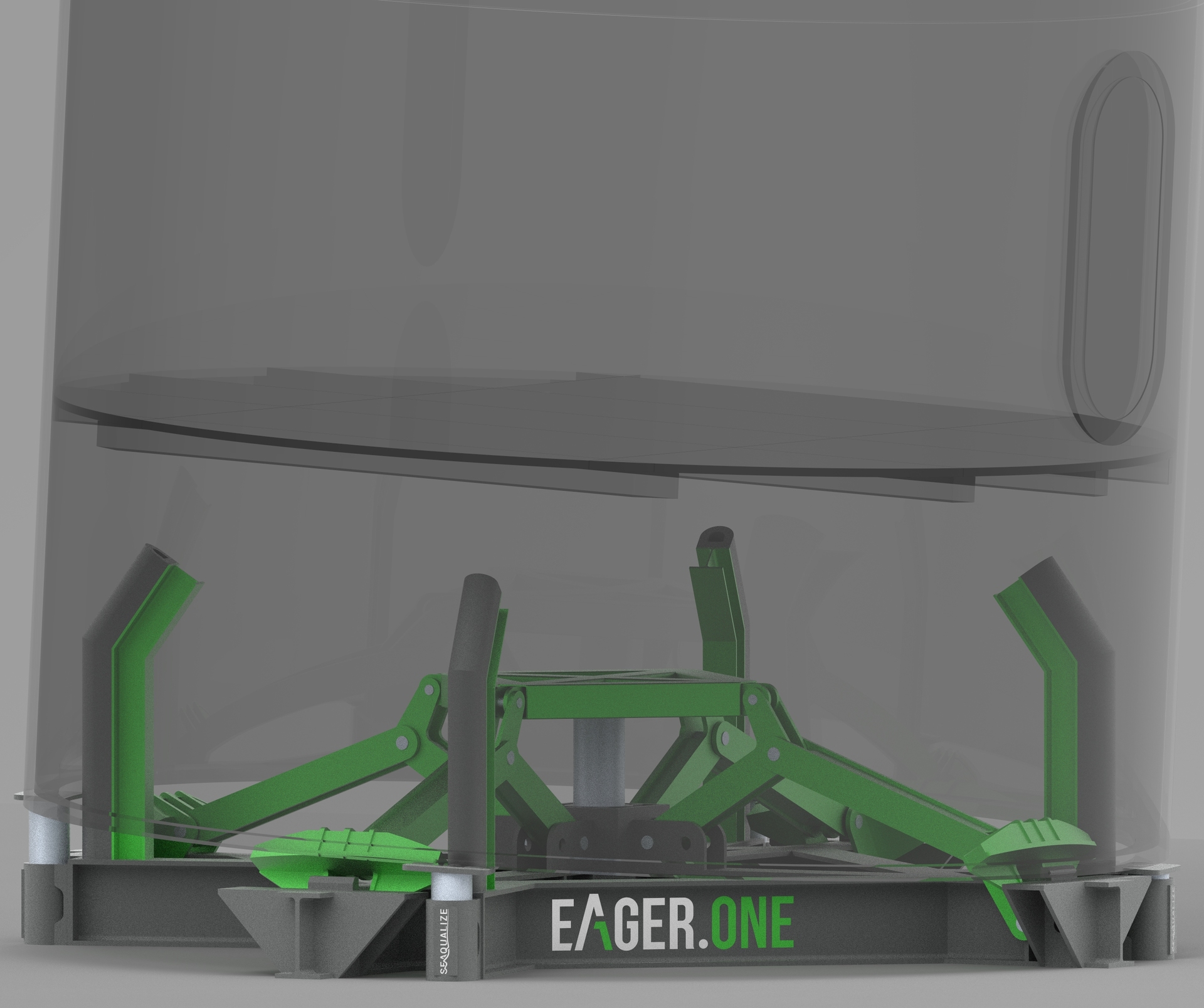
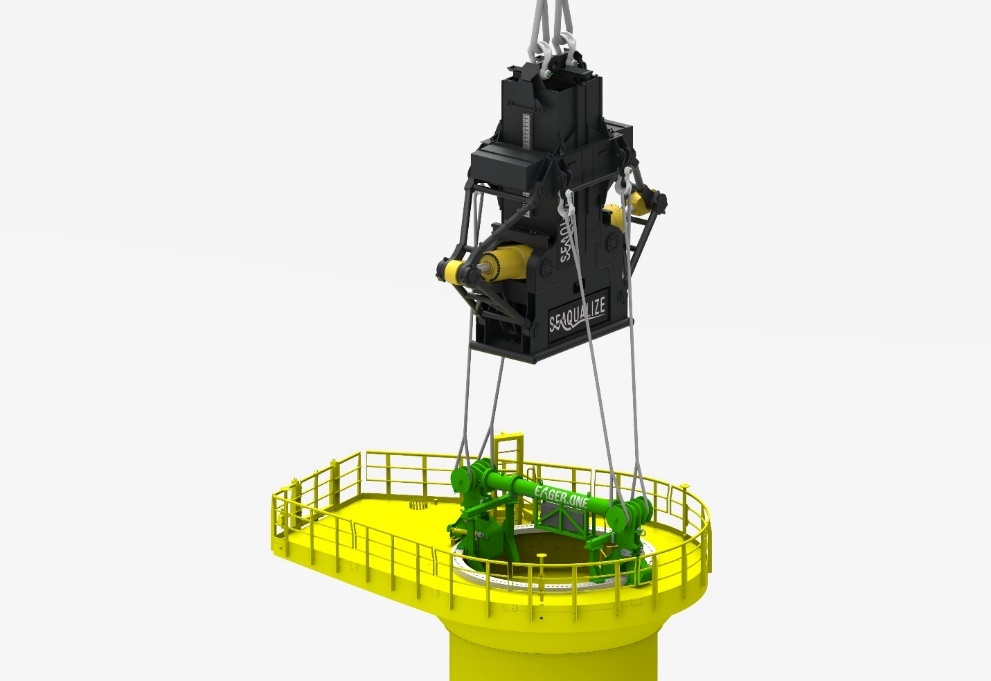
Wave Prediction for Additional Safety and Increased Workability
It is common to hear the term ‘Significant Wave Height’ or, Hs, when discussing the operability of specific offshore operations. However, reducing any given wave condition to a single parameter like Hs is a tremendous oversimplification. There are many combinations of sea and swell waves that can result in the same Hs, whilst they result in very different vessel motions. In the end, it is the vessel motions induced by these waves that actually matter. Using radar, motion sensors and innovative software Next Ocean’s WavePredictor (WP) can decompose a significant wave or vessel motion value into relative quiescent periods and extreme amplitudes, up to individual waves. By continuously translating predicted waves to vessel motions, the crew gets better insight in when it is likely to get close to the actual operational limits in terms of vessel motions. Operations can be temporarily paused at such times and safely continue in the quiescent periods in between, increasing the overall operation uptime.


Heading Advice
Even before any lifting operations take place the overall vessel motions of the barge can be reduced by optimizing the heading. The information on the surface waves gathered by the WavePredictor can be used to forecast vessel motions for all possible headings in the given wave conditions. This allows the barge operator to choose the optimal heading for any given sea state. This works both for sea waves, swell waves and for situation where both have a significant impact on the vessel motions.
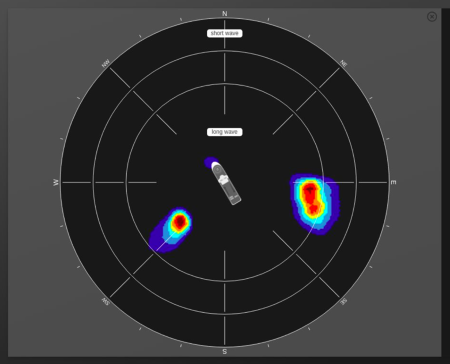
Approach Operability Study
Typically, marine operations can only be carried out up to a certain sea state, otherwise the dynamic responses of the vessel may become too large to satisfy the safety requirements. Setting this limit in terms of significant wave height (Hs) only, is widely used in the industry. However, for a floating vessel like a barge, other parameters such as the peak period (Tp) and wave direction (μ) or vessel heading, should also be considered. And it will be the motion responses of the vessel that will determine if it is safe to work, not necessarily driven only by the Hs.
Therefore, our approach is to derive the allowable sea states using response-based limiting criteria. For example, we can determine a maximum allowable heave amplitude and heave speed of the rigging point of a tower section and translate this into allowable sea states, described as a Hs & Tp plot for multiple headings. After obtaining the allowable sea states we can calculate the operability using long term hindcast data of the weather conditions of the applicable installation site. These operability analyses can be done both for only one activity (e.g. the offshore lift of a tower section) as well as for a complete project comprising of a series of sequential activities (e.g. the installation of 62 complete WTGs). From now on we will refer to “Project Weather Downtime analysis” for the simulation of the complete project, and “workability analysis” for the simulation of 1 activity only. Please also see the flow diagram below.
For both these type of analyses in this study, the governing offshore lift case in terms of motions is considered, being the stern most tower section with a height of 31m.

Workability Analysis Results
As a first step we have performed a workability analysis the Vineyard lease area. For this analysis we assume the utilization of the complete concept, thus a DP2 ADAPT barge combined with the inline Active Heave Compensation system(i-AHC), quick release seafastening, remote rigging and WavePredictor technology.
The workability for this integrated concept, will be compared with that of a regular DP2 barge and a regular Non-DP barge in beam seas. For a summary of the results see table below.
Summary of results Workability Analysis
| Fully integrated concept: ADAPT DP2+i-AHC+WP+smart tooling | Regular DP barge only | Regular barge (in beam seas) | |
| Yearly Workability [%] | 91.3% | 53.1% | 9% |
The results for the integrated concept are promising, for the offshore lift of the governing tower section an increase in workability of 35% to 50% is achievable using the full concept (ADAPT DP2 + i-AHC +WP), versus a standard DP barge2. Also see figure below.
An increase in workability of 35% to 50% is achievable using the full concept (ADAPT DP2 + i-AHC +WP), versus a standard DP barge

Please note that the results for the combined concept (ADAPT DP2 + i-AHC + WP) are based on the actual (vertical) response-based limits of the i-AHC tool, meaning that the load will be fully compensated all time4.
To appreciate the full benefit of the ADAPT barge one should compare fully integrated solution against the case of using a regular “dumb” barge that cannot weathervane. To illustrate the significance of the weathervane capabilities of the ADAPT barge, the workability is plotted for a ‘regular’ non-DP barge in beam seas (90 degrees) versus the workability of the weathervaning ADAPT barge in head seas,
The main reason for the big difference in workability between the non-DP barge and the ADAPT barge is that, when moving into beam seas, the horizontal motions and velocities become governing (over the compensated, vertical motions). The motions can be significantly reduced by choosing an optimal heading with the barge (as indicated by the WavePredictor). Something that is possible with the ADAPT barge because of its DP capabilities.
Project Weather Downtime analysis results
To get an idea of what this increase in workability would mean for a complete project we also performed some basic Weather Downtime Analyses for a fictive project where we compare the results of the full integrated concept versus a ‘regular’ DP2 barge and a ‘dumb’ barge in beam seas. The comparison will be in terms of the P50 monthly uptime percentage, the P50 project duration and the top 3 of the most limiting activities in terms of downtime. For this analysis again the Vineyard hindcast weather data is used and the project is assumed to comprise the installation of 62 WTGs.
For this analysis also the results look promising. From the summary tables below, it can be concluded that using the full integrated concept (ADAPT barge + i-AHC + WP) versus a regular (DP) barge (without heave Compensation) could lead to a significant increase in uptime of the WTIV, bringing down the project duration by months.
Summary of results Weather Downtime Analyses
| Full integrated concept (ADAPT+i-AHC+WP)5 | Regular DP barge (no i-AHC or WP)6 | Regular non-DP barge (in beam seas)7 | |
| P50 Project duration [days] | 174 | 317 | 777 |
| Most limiting activity | WTIV Jacking down | Blade rack lift from barge | Blade rack lift from barge |
| 2nd most limiting activity | WTIV Pre-loading & Jacking Up | WTIV Pre-loading & Jacking Up | Nacelle lift from barge |
| 3rd most limiting activity | Blade rack lift from barge | WTIV Jacking down | WTIV Pre-loading & Jacking Up |
Yearly Uptime percentages for WTIV
| P50 Uptime WTIV (Integrated concept) | P50 Uptime WTIV (‘Regular’ DP barge) | P50 Uptime WTIV (‘Regular’ non-DP barge in 90° seas) | |
| Total P50 Uptime | 52.1% | 31.3% | 12.5% |
Monthly uptime percentages for WTIV
| P50 Uptime WTIV (Integrated concept) | P50 Uptime WTIV (‘Regular’ DP barge) | P50 Uptime WTIV (‘Regular’ non-DP barge in 90° seas) | |
| JAN | 42.3% | 25.6% | 8.9% |
| FEB | 38.9% | 22.1% | 8.6% |
| MAR | 39.5% | 24.8% | 11.2% |
| APR | 42.7% | 24.0% | 10.8% |
| MAY | 54.2% | 35.6% | 11.4% |
| JUN | 65.1% | 46.9% | 16.7% |
| JUL | 76.6% | 59.1% | 14.2% |
| AUG | 63.0% | 46.1% | 18.9% |
| SEP | 41.7% | 24.2% | 10.3% |
| OCT | 45.0% | 25.1% | 10.4% |
| NOV | 42.8% | 24.2% | 11.3% |
| DEC | 41.3% | 24.9% | 9.9% |
If you are interested in detailed workability or weather downtime study for your project please contact us at Support@seaofgravity.com!
Assumptions and allowable limits used
The allowable response-based limits for the full ADAPT concept are presented in the table below under “Criteria 2”. For this case, the limits for the vertical motion and velocity are known limits, these are the actual limits of the i-AHC tool, meaning that up to these limits the load will be 100% compensated and will never lead to shock loads or to a premature lift off. The limits for the horizontal motion and velocity are estimated and will be driven by what the client will allow for.
For comparison, the allowable limits for the base case as presented on the right-hand side of the table below are assumed limits. The base case considered here is a DP2 barge only, without any additional technology. Actual allowable limits for the base case are to be detailed by clients.
| Criteria 2 – ADAPT DP2 + i-AHC | Criteria 1 – Base case | |
| Wave heading | 180 deg | 180 deg |
| Allowable vert. motion amplitude (MPM) | 2.3 m | 0.5 m |
| Allowable hor. Motion amplitude (MPM) | 2 m | 2 m |
| Allowable vertical velocity (MPM) | 0.7 m/s | 0.2 m/s |
| Allowable horizontal speed (MPM) | 1 m/s | 1 m/s |
For the assumed offshore activities used for the Weather downtime analysis please refer to the table below. This table presents the assumed activities, their durations and weather limits. For the different cases (integrated ADAPT barge solution, DP barge and ‘regular’ barge) only the weather limits for the lifting activities are adjusted.

The Feeder Barge Alliance – Solutions Together
Workability limits are never stand-alone: when workability limits are increased, new bottlenecks occur that limit the full use of the improvement. Such limits are hard to identify when looking at the workability on a piece-by-piece basis. Companies need to look at potential workability improvement comprehensively, in one integral workability analysis.
Eager.one
Eager.one is a company that designs and supplies bespoke project equipment for lifting, handling, seafastening and access. Next to providing equipment we also design lifting and rigging plans for offshore installation. Experience gained from preparing these plans together with wind farm installation contractors, gives us great insight on how to design our tools for swift and safe operations. Eager.one was established in 1979 as an engineering and consultancy service provider, active in the upcoming petrochemical and process industry in the Netherlands. In 2013, Eager.one started a new Design and Construction division. This division now manages projects from the engineering phase, up to supplying fabricated and tested equipment.
Next Ocean
Next Ocean is a company that enables to reduce risks and increase workability offshore by providing detailed insights in the local wave conditions. Using Next Ocean’s WavePredictor it is possible to forecast motions of a vessel for different headings. And by using radar to scan each and every individual wave in the vicinity of the vessel, Next Ocean’s WavePredictor provides insight in upcoming quiescent periods to safely execute critical steps in the operations. Next Ocean is founded in 2016 as a spin-off from the Delft University of Technology.
Seaqualize
Seaqualize is an offshore innovation startup, specialized in the design, building and deployment of motion compensation systems based on its patented Balanced Heave Compensation technology. Besides design and integration of BHC systems for 3rd party tooling, Seaqualize focusses on building and leasing out of the Delta series tooling, the world’s first inline-AHC system for heavy loads in above-sea operations.
SEA.O.G Offshore
SEA.O.G Offshore is a field tested integrated service provider to the offshore energy industry. With dedicated team of more than 40 professionals they have extensive industry experience in WTG transport trusted by the biggest names in wind. Nearly half of the national installed capacity for 2020 were large rotor diameter turbines transported under their supervision. The team has supported technical marine operations of over 35,000 lifts for wind OEMs in more than 35 North American ports. Services for the offshore industry include turnkey receiving, marshalling, and offshore delivery of WTGs and Foundations. Through the novel approach to offshore feedering they can offer significant uptime while improving safety, cost, and performance efficiencies through application of advanced technology, marshalling methods, and a robust newbuild strategy.
- JONSWAP spectra are assumed for this study↩︎
- For both DP barges it is assumed that the barge will always be able to weathervane into 180-degree seas. These results are based on the response-based limits, for more info please see Assumptions.↩︎
- The limits for the vertical motion and velocity are known limits, these are the actual limits of the i-AHC tool. The limits for the horizontal motion and velocity are estimated and will be driven by what the client will allow for.↩︎
- Found using Most Probable Maxima, with a probability of exceedance of 0.001↩︎
- Weather Limits are set at Hs=2.5m & Tp=10s. These limits are the actual limits found using the response-based limit approach for the workability analysis in head seas. See Assumptions.↩︎
- Weather Limits are set at Hs=1.2m & Tp=7s. Based on the response-based limits for the base case, see Assumptions.↩︎
- Weather Limits are set at Hs=0.7m & Tp=7s. Based on estimated using response-base limits with higher tolerances for horizontal motions.↩︎
